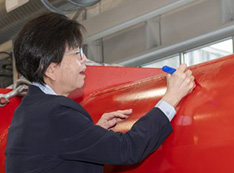Machine capabilities overcome support tube size and straightness imperfections in executing intended designs. Minor imperfections to magnetic multipoles due to manufacturing tolerances are minimized by means of magnetic measurements between double coil layers, with measured errors compensated in successive coil layers. Coils and magnets made with this technology have been used at Brookhaven Lab and delivered for use in accelerators and experiments worldwide over the last two decades, including DESY in Germany, KEK in Japan, IHEP in China, and most recently for three generations of antimatter traps for the ALPHA experiment at CERN. The majority of the superconducting magnets in the Interaction Region of the new Electron-Ion Collider (EIC) at Brookhaven Lab will utilize this technology, and towards that goal the two existing machines are upgraded with new, more reliable hardware and software, and also with increased capacity. A third machine is planned for production use, and plans are underway for a new machine capable of delivery of larger NbTi and HTS conductors. The new machines are now capable of fabricating coils from 20 millimeter in diameter up to over 700 millimeter in diameter, and in lengths up to five-and one half meters.
The Superconducting Magnet Division employs unique technology to build compact, precise, superconducting magnets for the Electron-Ion Collider (EIC) Interaction Region and more.
SMD’s Direct Wind Coil Facility uses a novel technology exclusive to Magnet Division whereby one of three available round niobium titanium conductors is deposited onto a cylindrical or tapered support tube, in infinitely variable patterns of electromagnetic design. This technology eliminates the need for costly precision coil tooling and components, and instead delivers the electromagnetic design directly from scientist to winding machine.
The output of the Superconducting Magnet Division is various superconducting magnets for use in both particle accelerators and experimental facilities. We:
- work within the U.S. HENP community on future facilities and technologies;
- collaborate with other science institutions world wide to both provide and develop superconducting technologies;
- support the ongoing Brookhaven research program with emphasis on the RHIC complex.
Capabilities include:
- Magnetic structure design
- Superconducting magnet fabrication
- Vertical and horizontal cryogenic testing
- Magnetic field measurements




